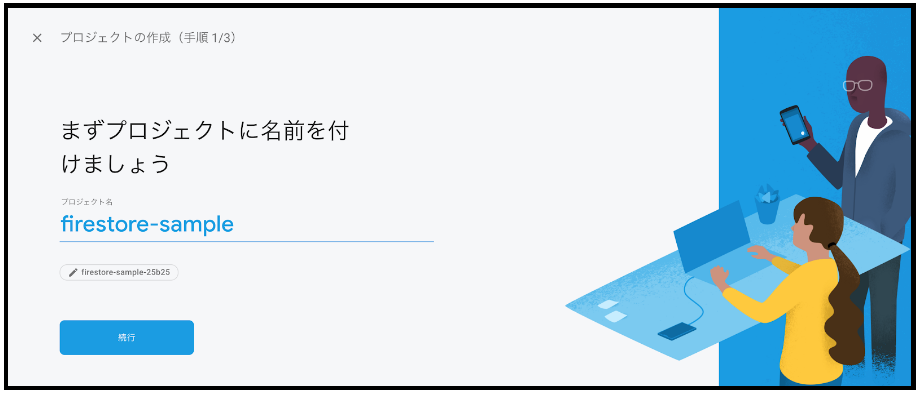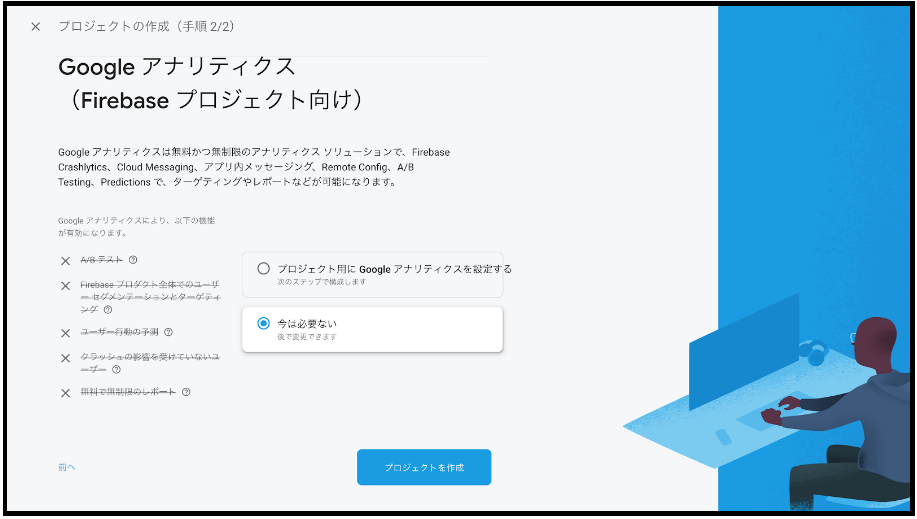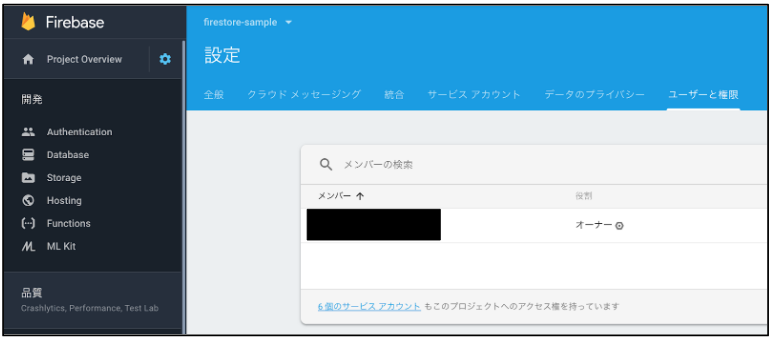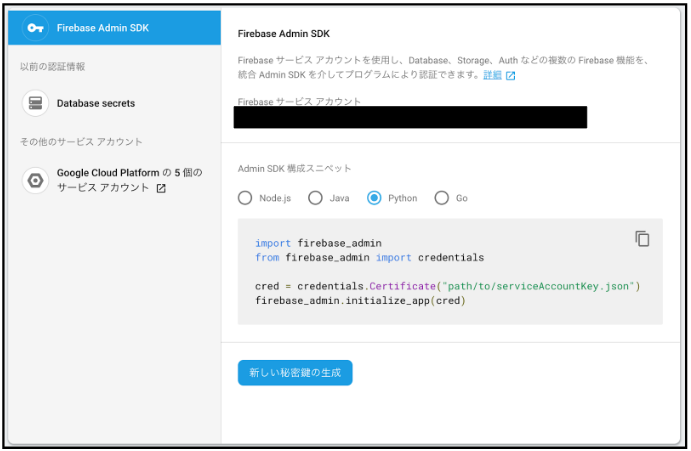Cloud Firestore入門。Pythonから読み書きと運用周り調査
所用があり、Cloud Firestoreについて調べたので、メモを残しておきます。
目次
読み書きサンプル(Python)
まずは機能を知るために、読み書きを試してみます。
こちらを見ながら進めます。
プロジェクトの作成
検証用のプロジェクトを追加

プロジェクト名を入力

検証用プロジェクトなのでアナリティクス不要

データベースの作成
Database --> データベースの作成

今回は検証なのでテストモード

ロケーションを指定

クライアント用ライブラリインストール
ウェブ、iOS、Java Android、 Kotlin Android、Java、Python、Node.js、Go、PHP、C#、Rubyが選択できます。 今回はPythonを使ってみます。
「pipenv」の使い方については、こちらをご参照ください。
$ pipenv --three $ pipenv install firebase-admin $ pipenv shell
SDKの環境設定
設定-->ユーザーと権限

サービスアカウントのリンクをクリック

新しい秘密鍵の生成

$ export GOOGLE_APPLICATION_CREDENTIALS="{秘密鍵jsonのパス}"
データの書き込み、読み出し
サンプルコード
$ cat sample.py import firebase_admin from firebase_admin import firestore firebase_admin.initialize_app() db = firestore.client() doc_ref = db.collection(u'users').document(u'alovelace') doc_ref.set({ u'first': u'Ada', u'last': u'Lovelace', u'born': 1815 }) doc_ref = db.collection(u'users').document(u'aturing') doc_ref.set({ u'first': u'Alan', u'middle': u'Mathison', u'last': u'Turing', u'born': 1912 }) users_ref = db.collection(u'users') docs = users_ref.get() for doc in docs: print(u'{} => {}'.format(doc.id, doc.to_dict()))
$ python sample.py
sample.py:28: DeprecationWarning: 'Collection.get' is deprecated: please use 'Collection.stream' instead.
docs = users_ref.get()
alovelace => {'first': 'Ada', 'last': 'Lovelace', 'born': 1815}
aturing => {'first': 'Alan', 'last': 'Turing', 'born': 1912, 'middle': 'Mathison'}
ログについて
Cloud Firestoreにデータを読み書きしてみましたが、Firebase ConsoleやCLIツールで、ログを確認する機能を見つけることができませんでした。
$ firebase Usage: firebase [options] [command] Options: -V, --version output the version number -P, --project <alias_or_project_id> the Firebase project to use for this command -j, --json output JSON instead of text, also triggers non-interactive mode --token <token> supply an auth token for this command --non-interactive error out of the command instead of waiting for prompts --interactive force interactive shell treatment even when not detected --debug print verbose debug output and keep a debug log file -h, --help output usage information Commands: auth:export [options] [dataFile] Export accounts from your Firebase project into a data file auth:import [options] [dataFile] import users into your Firebase project from a data file(.csv or .json) database:get [options] <path> fetch and print JSON data at the specified path database:instances:create <instanceName> create a realtime database instance database:instances:list list realtime database instances database:profile [options] profile the Realtime Database and generate a usage report database:push [options] <path> [infile] add a new JSON object to a list of data in your Firebase database:remove [options] <path> remove data from your Firebase at the specified path database:set [options] <path> [infile] store JSON data at the specified path via STDIN, arg, or file database:settings:get [options] <path> read the realtime database setting at path database:settings:set [options] <path> <value> set the realtime database setting at path. database:update [options] <path> [infile] update some of the keys for the defined path in your Firebase deploy [options] deploy code and assets to your Firebase project emulators:exec [options] <script> start the local Firebase emulators, run a test script, then shut down the emulators emulators:start [options] start the local Firebase emulators experimental:functions:shell [options] launch full Node shell with emulated functions. (Alias for `firebase functions:shell.) firestore:delete [options] [path] Delete data from Cloud Firestore. firestore:indexes [options] List indexes in your project's Cloud Firestore database. functions:config:clone [options] clone environment config from another project functions:config:get [path] fetch environment config stored at the given path functions:config:set [values...] set environment config with key=value syntax functions:config:unset [keys...] unset environment config at the specified path(s) functions:delete [options] [filters...] delete one or more Cloud Functions by name or group name. functions:log [options] read logs from deployed functions functions:shell [options] launch full Node shell with emulated functions help [command] display help information hosting:disable [options] stop serving web traffic to your Firebase Hosting site init [feature] setup a Firebase project in the current directory list list the Firebase projects you have access to login [options] log the CLI into Firebase login:ci [options] generate an access token for use in non-interactive environments logout log the CLI out of Firebase open [link] quickly open a browser to relevant project resources serve [options] start a local server for your static assets setup:emulators:database downloads the database emulator setup:emulators:firestore downloads the firestore emulator setup:web display this project's setup information for the Firebase JS SDK target [type] display configured deploy targets for the current project target:apply <type> <name> <resources...> apply a deploy target to a resource target:clear <type> <target> clear all resources from a named resource target target:remove <type> <resource> remove a resource target tools:migrate [options] ensure your firebase.json format is up to date use [options] [alias_or_project_id] set an active Firebase project for your working directory
運用上「いつ、誰が、何をしたのか」を知りたい場面は多いと思います。
運用事例について調べたところ、下記の記事でログ取得について記載されていました。
Firestoreには誰がどんな操作をしたか、ログを残す機能が無いようです。
こちらの記事では、「Cloud Firestoreを使った場合のログ運用」だけでなく、「Cloud Firestoreのデータを検索する」、「Cloud FirestoreとCloud Functionsを連携させた場合のパフォーマンス改善」など、とても参考になる知見が多数公開されていました。
知見を共有いただいてありがとうございます。
バックアップについて
運用することを想定した場合、バックアップをとっておきたいです。
2018年8月頃から「gcloud」コマンドでバックアップとリストアができるようになったようです。
バックアップするには、課金を有効にする必要があり、バックアップデータは、Google Cloud Storageのbucketに保存されるようです。
以上、Cloud Firestore入門と、気になった点のメモ書きでした。